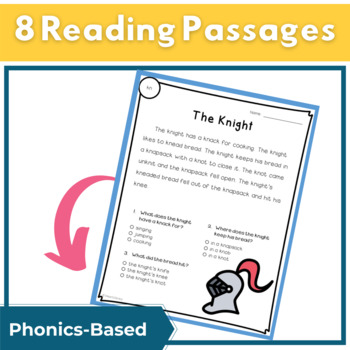Knowing the differences between oral and silent reading is vital to an individual's educational lifetime: Oral reading provides the thought from the printed page, while silent readers absorb the thought from the text. Oral reading actually follows an instant recognition of a thought, while silent readers immediately get. To model good silent reading practices and to demonstrate an interest in books and a love of literature, spend the first five minutes looking at books, too. Encourage those students who struggle with reading or are prereaders to picture-read the story and connect words from the text to the pictures.
- Basic Reading Comprehension Worksheet Pdf
- Silent Reading Comprehension Skills
- Silent Reading Comprehension Assessment
| |||||
This set of silent letters reading passages helps first grade, second grade, and third grade students build their reading fluency and comprehension skills. Each set of passages focuses on a specific set of phonics skills, and this set emphasizes words that contain silent letters. Included in this. Reading comprehension This survey is an informal assessment used to determine student comprehension after silently reading a passage. The target ages are five to eight and the time required is ten to fifteen minutes. The students are to read the passage and then answer the questions that follow. The Advantages of Sustained Silent Reading Enhances Reading Enjoyment. Readers choose their own materials for sustained silent reading, so children can pick books. Increases Comprehension. Readers don't have to pay as much attention to the pronunciation of every single word when they.
It’s a classroom practice that’s been around for decades and goes by many names: SSR, DIRT (daily independent reading) or DEAR (drop everything and read). Essentially it’s a block of time, such as ten to twenty minutes, taken daily or weekly, in which students can select books independently and quietly read.
Research on the effectiveness of SSR is a mixed bag. A report from the National Reading Panel in 2000 claimed there were not enough studies to draw any scientific conclusions that SSR benefits students. However, the panel made it clear that SSR may have a positive influence regarding fluency, vocabulary development, and reading comprehension. Many teachers have seen the positive effects in their classrooms and work SSR into the curriculum, from elementary up through high school.
The benefits of SSR
Basic Reading Comprehension Worksheet Pdf
Often with SSR, reading becomes enjoyable for students who follow their particular interests in selecting books, rather than having to read assigned books. Reading comprehension with SSR often improves. “Readers don’t have to pay as much attention to the pronunciation of every single word when they read silently, so they can concentrate on reading for understanding,” writes Karen LoBello, in “The Advantages of Sustained Silent Reading.”

Often students can figure out unfamiliar vocabulary words when read in context and remember them now having a frame of reference. And by reading different styles of writing, their own writing skills are intuitively influenced and improved.
Strategies for success
Silent Reading Comprehension Skills
- Make a commitment to SSR and stick to it. You won’t see any results if you’re inconsistent scheduling the time. Students in turn will develop more stamina, developing their reading “muscles,” says one Central Ohio teacher. They will also start to look for additional titles that interest them because they know SSR is a given.
- Allow your students to make their own choices with helpful guidance from you. Younger students may need to be coached on how to choose the right book for them at or slightly above their reading level, while older students might need to be directed toward more appropriate material.
- Books can come from your own classroom library, the school library, or home. Make sure you have a few titles on hand for students who “forget” to bring in their book.
- You can easily incorporate writing activities with SSR. Students can journal about their reading experiences, create a log of the books they have read, or write a review of the book so their classmates know if they should pick up that book.
- If you have enough space, create an area for SSR that enhances the experience. Bean bag chairs, large pillows and an area rug encourages the kids to get comfy and get lost in their books.
- Make sure you establish clear rules about SSR behavior. Chitchat from some students can distract the entire class.
- Show the students good reading behavior and read your own book. “SSR time is not a time for teachers to correct papers or plan the next day’s lessons,” advises EducationWorld.com. “Teachers should be right there on the floor (or in another comfortable spot) – modeling a lifelong love of reading.”
Silent Reading Comprehension Assessment
Recommended Reading
The SSR Handbook: How to Organize and Manage a Sustained Silent Reading Program. Janice L. Pilgreen (2000)
Building Student Literacy Through Sustained Silent Reading. Steve Gardner (2005)
Revisiting Silent Reading: New Directions for Teachers and Researcher. Elfrieda H. Hiebert (2010)
